Preceded by Biswanath Das Nationality Indian | Preceded by Post created Name Krushna Gajapati Succeeded by Biswanath Das | |
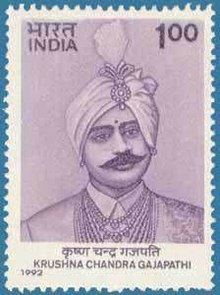 | ||
Parents Shri Goura Chandra Gajapati Alma mater Newington College, Madras Presidency | ||
Maharaja krushna chandra gajapati narayan deo is the first priminister of odisha of
Krushna Chandra Gajapati (26 April 1892 – 25 May 1974), honorably known as Maharaja Sir Krushna Chandra Gajapati Narayana Dev KCIE, was a key personality in the formation of an Independent Odisha State and regarded as it's architect.Gajapati District of Odisha was named after him..
Contents
- Maharaja krushna chandra gajapati narayan deo is the first priminister of odisha of
- Khoj on Rajaghara Katha
- Early Life and education
- Role in the formation of Independent Odisha State
- Social and Philanthropic Services
- Political Services and honours
- Death
- References
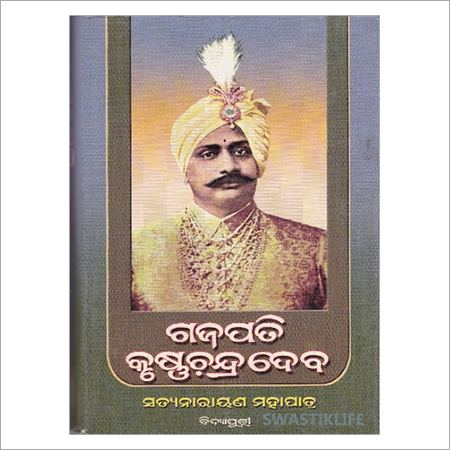
He was interested in Oriya culture including it's literature, art and music. He was also interested in sporting, in particular horse-riding (in which sport he excelled).
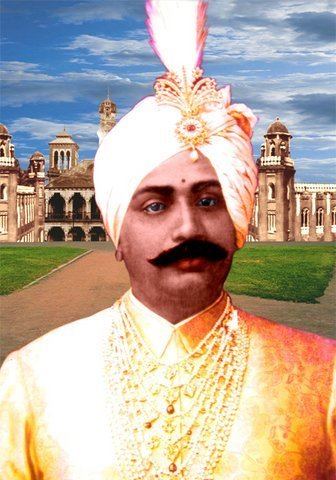
Khoj on Rajaghara Katha
Early Life and education
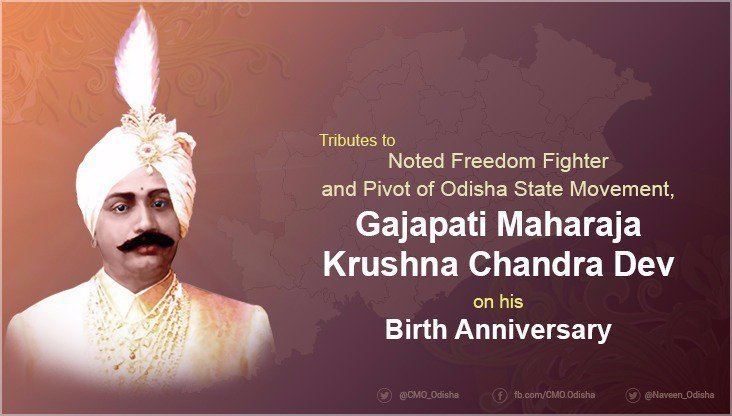
Maharaja Krushna Chandra Gajapati Narayan Dev, the scion of the great Ganga Dynasty of Paralakhemundi, was born on 26 April 1892 to the King of Paralakhemundi Goura Chandra Gajapati and Radhamani Devi.
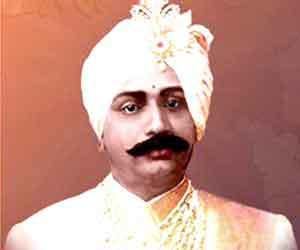
Shri Gajapati received his elememntary education at the local Maharaja High School of Paralakhemundi and then entered the exclusive Newington College in Madras for higher studies. During his studies in Madras, he lost his father Shri Goura Chandra Gajapati. After completing his studies at Madras he returned to Paralakhemundi and in the year 1913 married the princess of Kharasuan State. In the same year he held the reign of the State on 26 April 1913.
Role in the formation of Independent Odisha State
Maharaja Krushna Chandra Gajapati was the pivot of the Oriya movement for the formation of an Independent Odisha state on the basis of Language and homogeneity. He spent extensively from his royal treasury to materialise this effort. Utkal Gourav Madhusudan Das, Utkalamani Gopabandhu Das, Maharaja Krushna Chandra Gajapati, Fakir Mohan Senapati and other eminent members of Utkal Sammilani demanded a separate Odisha state with an amalgamation of Oriya speaking areas in the then Orissa-Bihar-Bengal province. This proposal was approved in the Bihar-Orissa Legislative Assembly. As a member of the Utkal Sammilani, he put forward the proposal of a separate Odisha state in the first Round table conference held in London on 16 November 1930.
Finally, with the effort of Maharaja Krushna Chandra Gajapati and Utkal Sammilani, the separate state of United Odisha was formed on 1 April 1936. From that day, 1 April is celebrated by the Oriya people as Utkal Divas. Gajapati's own state of Paralekhemidi in Vizagapatam district was partitioned into two – with the capital and most of the princely state coming under Orissa and the remaining Telugu-majority areas remained in Madras Presidency. In 1937, the first Governor of Odisha, Sir John Austin Hubback invited Krushna Chandra Gajapati Dev to form the cabinet. Shri Gajapati was the first Prime Minister of the Odisha state from 1 April 1937 to 18 July 1937. He was the Prime Minister of Odisha for the second time from 24 November 1941 to 30 June 1944.
Social and Philanthropic Services
He was instrumental in the establishment of the Utkal University, the SCB Medical College and also the famous Central Rice Research Institute in Bidyadharpur, Cuttack, which is one of the largest of its kind in Asia. He set up many hospitals, schools, colleges, industrial institutions, modern agricultural farms and provided a record number of 1281 irrigation sagars or water-tanks in his agriculturally dominant native taluk. For this reason, the undivided Ganjam District was given the title 'the rice-bowl of Odisha'. Under Gajapati, scholarships were awarded to thousands of poor and meritorious students in humanities, science, agriculture, medicine, and engineering, among others.
Political Services and honours
Shri Krushna Chandra Gajapati was an Honorary Captain in the First World War. He received a rare Sanad in 1920 from the then Viceroy and Governor General of India, in recognition of his services rendered to the Indian Army during the Great War and as a mark of commendation. He was a Member of the Royal Commission on Agriculture, under the Chairmanship of Lord Linlithgow. He was also a Member of the Madras Legislative Council.
He was awarded honorary Doctorates by the Utkal University and the Berhampur University, and was appointed a Knight Commander of the Order of the Indian Empire (KCIE) in the 1946 New Year Honours. He was one of the founding fathers of the Indian Constitution, being a Member of the Constituent Assembly of India. His contribution to horse-racing and his encouragement for horsebreeding in India are notable.
Death
The son of Odisha, Sri Krushna Chandra Gajapathi died on 25 May 1974 at the age of 82, leaving behind numerous relatives, friends, admirers and well wishers. He was accorded a state funeral by the Government of Odisha and was cremated with full honours at Paralakhemundi.
